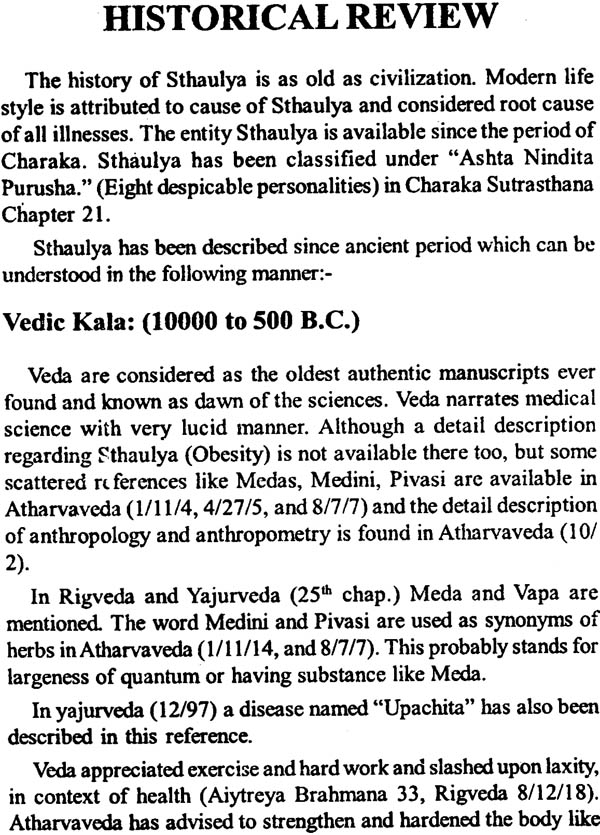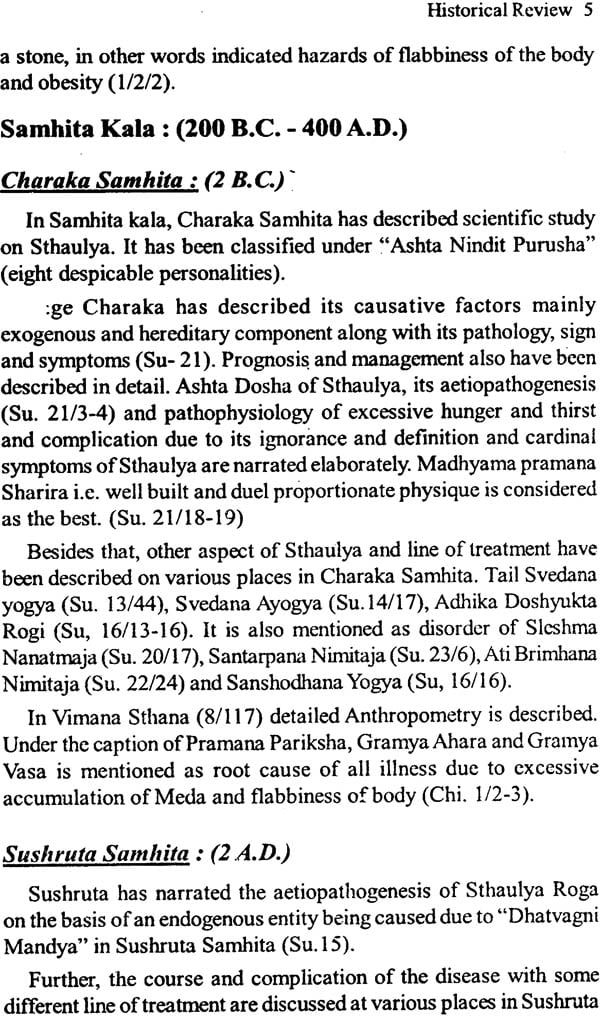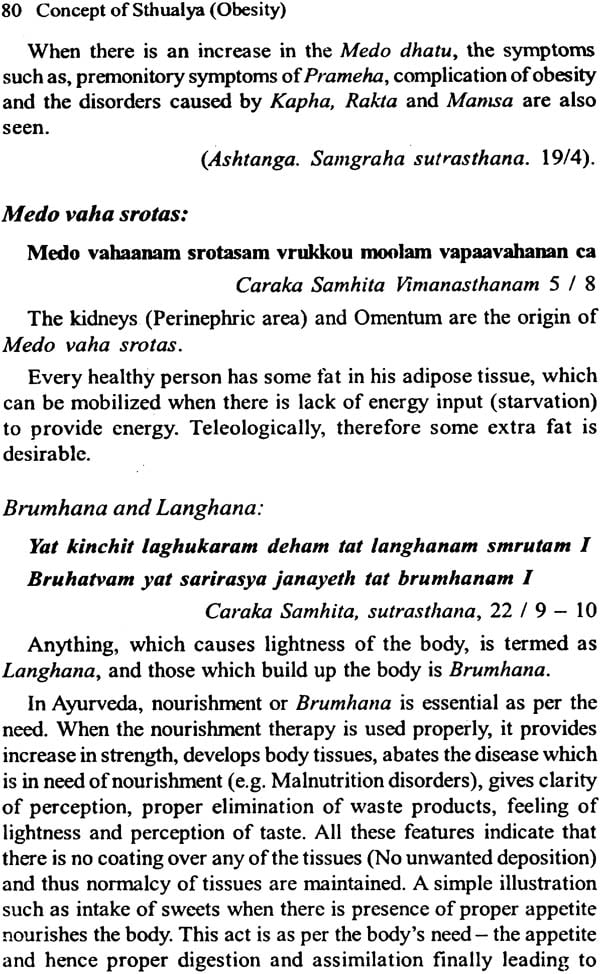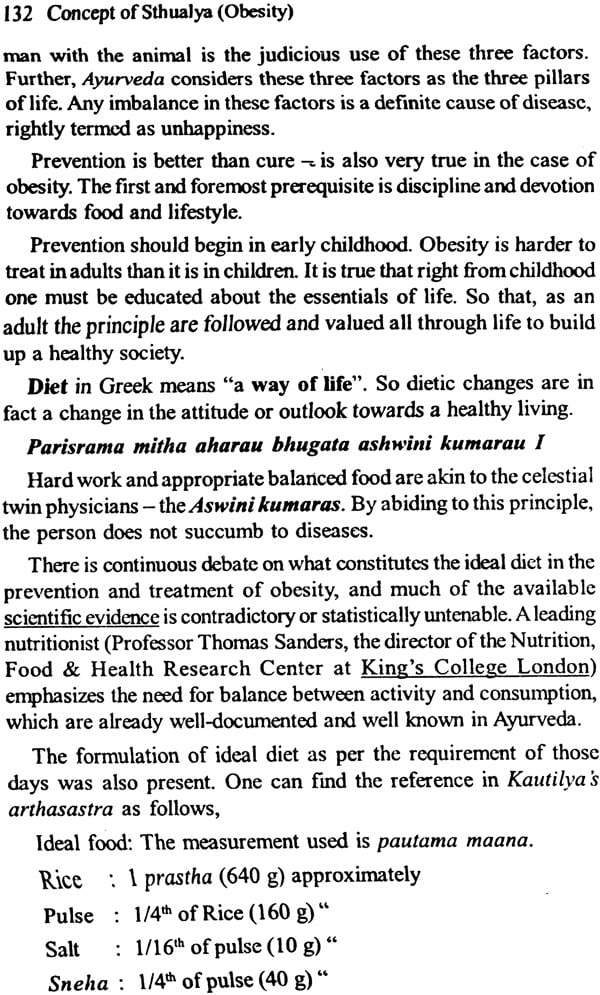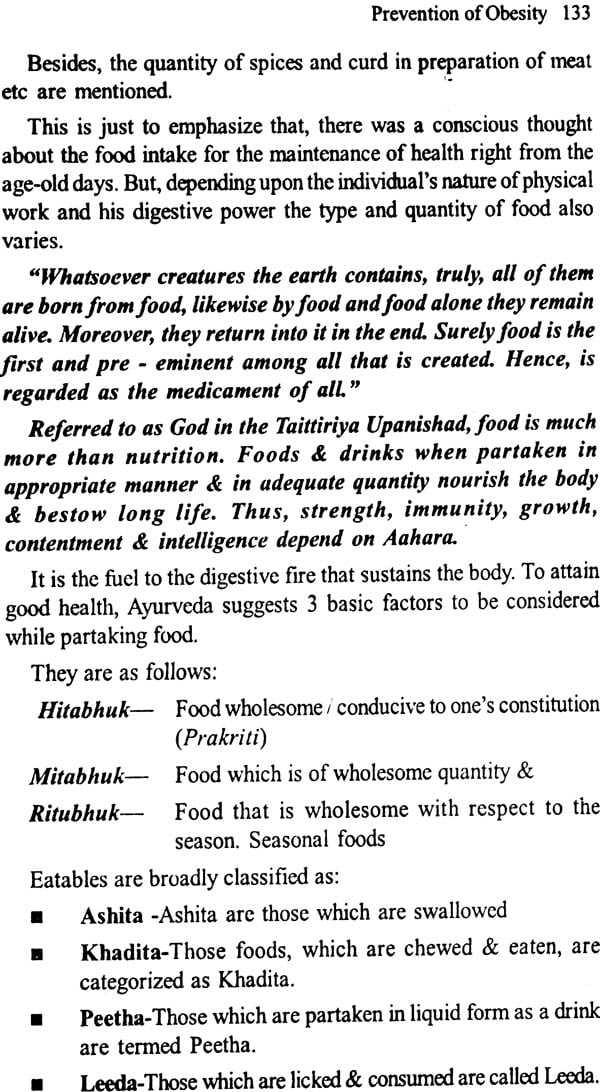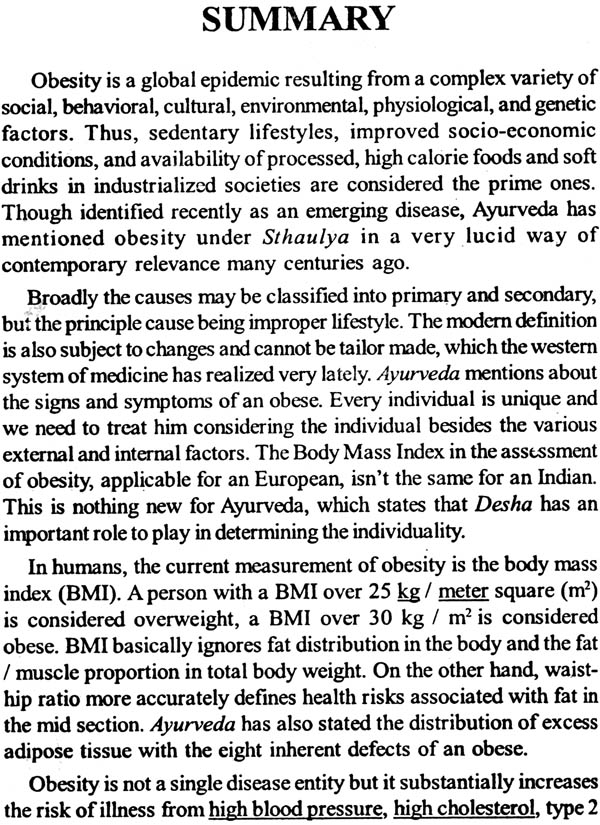
Concept of Sthaulya (Obesity)
Book Specification
| Item Code: | NAM509 |
| Author: | Dr. Feeroz Khan, Dr. Nitin Urmaliya and Dr. S. Ranessh |
| Publisher: | Chaukhambha Orientalia |
| Language: | English |
| Edition: | 2016 |
| Pages: | 222 (43 B/W Illustrations) |
| Cover: | Paperback |
| Other Details | 8.5 inch X 5.5 inch |
| Weight | 220 gm |
Book Description
AYURVEDA is the best AMRUTA (Immortality) says the Shastra. Any knowledge should be relevant to all times. Though, Ayurveda is labelled as an ancient indigenous health system, it caters to the present day's health issues and hence is of contemporary relevance - truly modern!
Today, we have forgotten the art of living wisely. Thus, have ended up living life miserably resulting in many lifestyle disorders pertaining to the body and mind. Ayurveda deals with life in a holistic way encompassing every aspect of life.
Obesity is one among the lifestyle disorders which, has increased at an alarming rate Worldwide and India is no exception. This book is all about knowing and understanding obesity in a comprehensive manner and to figure out management strategies the Ayurvedic way. The information has been compiled after in depth understanding of various Ayurvedic literatures. The book also deals with the present day understanding of obesity viewed by the western bio medicine.
Ayurveda is a dynamic health system not because it has wonderful herbs / secret remedies but due to the fact that it aids nature in restoring the natural strength in every individual. The term "Personalized Medicine" is an integral part of cikitsa or management in Ayurveda. It signifies the need of a very comprehensive approach, very much specific to the individual.
This is because each individual is unique.
Health is dependent on Bala. Management in Ayurveda (Kriya krama) is to restore Health or Bala, wherever possible and to the possible extent.
So The Purpose of this book is to provide concise, essential, complete & readable information on Basic and applied aspects of Obesity. Selection of subject matter and its presentation is based on the post-graduation and teaching of the student. Stress is given on ayurvedic & modern aspects, which are clinically important, and an effort has been made to correlate physio-pathology of the disease.
While preparing this book we have taken the special care to cover and focus all the aspects and concepts of ayurved as well as Morden on obesity. But unnecessary details have been avoided. Information is arranged according to sequence. It is hoped that the students & practitioners will find the book useful and fruitful for understanding the Obesity as clinical as well as theoretical point of view. Further queries, valuable suggestions and healthy criticism for the improvement of the book are always welcome and shell be thankfully acknowledged.
"Take things seriously but yourself lightly" being the right kind of an attitude has unfortunately become "take things lightly but yourself seriously. This has led to many problems in the society and health too is no exception. Man in the true sense is one who has the ability to discriminate and so, is a gifted creation. In the present era, Man has become alien to Nature and hence today, we have advanced medicines and many increasing diseases .as well. We have complicated our living. In short, we are alien to or away from Nature. Since recent times, we have been talking about lifestyle disorders. Among these lifestyle disorders, a major share is attributed to Obesity, similar to its bulky nature. The following lines talks about obesity, lifestyle, prevention and management aspects. We talk about lifestyle without understanding life and knowing what lifestyle is. So, it is the knowing and understanding of life and all the aspects attributed to life synonymous with Ayurveda, which can address these issues effectively.
OBESITY:
Obesity is the state of being Obese, meaning extremely fat or corpulent. The word Obese is derived from the Latin root "Obesus" meaning fat, the French word is "obedo", its past participle - Obesus, meaning to eat away or devour. Thus, in simple terms obesity is an abnormal increase of fat in the subcutaneous connective tissues. The other synonyms of fat are adipose and lipid, which are derived from a Latin root "adeps" - fat and Greek root "lipos" - fat respectively.
A wide range of words is used to convey obesity in Thesaurus, corpulent, fat, gross, heavy, outsize, plump, podgy, portly, rotund, stout and tubby. True to the body bulk seen in obese persons, the body also stores a wide range of health related issues. Anything that leads to a continuing imbalance between food intake and energy consumption (positive energy balance) will lead to obesity and hence, Obesity is a condition in which the natural energy reserves of a mammal (such as a human), which is stored in expanded far beyond usual levels to the point where it is believed to pose a health risk, "Fat becomes fatal". Silavana Vergara of Italy, who was crowned Miss Fatty 2006, weighed 156 kgs. But, she must be very much aware that fat isn't fun, for all the health complications she has been facing.
Obesity is identified as a nutritional disorder very recently since last thirty years or so in the modernized world. It still thrives as one of the most important, yet preventable diseases. Amazingly, the concept of obesity has been stated lucidly by the ancient texts of Ayurveda, which dates back to 15th century BC. Obesity refers to Atisthualya or Medo roga, which corresponds to the primary and secondary types of obesity in the present context respectively. Sthula refers to obese and Sthaulya to obesity.
The root word as given in Vachaspatyam; "Sthula- Brumhane", meaning to nourish. In Amarakosha - it depicts, Corpulence, nourishment, motionless or dull, that speaks about the activities of the obese.
Medo roga - Documented as a commonly known disorder during Gupta and post Gupta period. Excessive eating and alcoholic beverages were the main cause of this abnormality. As a result, the body becomes heavy.
In Ayurveda, obese persons are among the eight undesirable phenotypes. The context of obese personality as mentioned in Caraka Samhita comes to light when there is the need to abridge the gap between the drug and the disease in an individual. Herein, we have three entities, namely the drug (dravya), the disease (Roga) and the individual affected with the disease (Rogi). So, when talked about the individual, what should be his personality to withstand the usage of the drug? The overall potency of the drug is seen in a well- built individual and in the undesirable types especially, the obese and the emaciated, the use of medicines should be with utmost care. Thus, treatment is restricted in case of these two undesirable phenotypes. Speaking about the obese, who is considered even more worse than the emaciated, the following points are significant.
The above verse speaks about the incapability of the obese to withstand the disease itself and how can they withstand the effect of such strong drugs? Thus, though the body proportion is large they are in fact delicate and feeble and so can be named as Weak Giants. With this brief introduction to obesity in Ayurvedic perspective, let us get into the present understanding of this global epidemic.
Phylogenetically, arthropods are the primitive animals to store fat in true adipose tissues of the body. Obesity in wild animals is relatively rare, but it is common in domestic animals like barrows and household pets who may be castrated, spayed, overfed and under exercised. This implies that animals basically are aware of their food requirements. The energy input in animals that is, eating behaviour is finely regulated in animals. Even when given a limitless access to the food the animal eats only, as much required and not more.
Have we seen an obese Goat? The goat inspite of continuous feeding burns its calories by its activity. Similarly, even the domesticated cats or dogs do not eat when sufferings from indigestion. We often see them to feed on some plant to tickle its palate and induce vomiting. How does the animal know that it is worthwhile to observe fast? But, we act contrary. Thus, man in the present times has forgotten the judicious use of many of his basic requirements though he claims to be advanced in many aspects. As we are drifting away from nature, we are already in chaos.
Contents
| Preface | VII | |
| Acknowledgement | IX-XIII | |
| 1 | Introduction | 1 |
| 2 | Historical Review | 4 |
| 3 | Prevalence of Obesity In India | 12 |
| 4 | Disease Review | 17 |
| 5 | Correlation Between Ayurved and Modern | 31 |
| 6 | Aetiology Of Obesity | 32 |
| 7 | Actiology according to Harrison's Principles of Internal Medicine | 43 |
| 8 | Couses of Obesity as per ayurveda | 46 |
| 9 | Some Facts Related to Obesity | 52 |
| 10 | Mechanism of Eating Behaviour | 55 |
| 11 | Factors Affecting Basal Metebolic Rate | 57 |
| 12 | Measurement of Basal Metabolic Rate | 59 |
| 13 | Energy Output | 60 |
| 14 | Concept of Food Metabolism-Modren Physiology | 62 |
| 15 | Untility of Glucose In The Body | 64 |
| 16 | Factors Influencing Point on Cholesterol | 67 |
| 17 | Few Noteworthy Points on Cholesterol | 69 |
| 18 | Adipose Tissue | 71 |
| 19 | Fat Distribution | 72 |
| 20 | Basic Principled And Metabolism In Ayurveda | 73 |
| 21 | A Brief Introduction to Dosha, Dhatu and Mala | 75 |
| 22 | The Concept of Agni | 77 |
| 23 | The Importance of Meda | 79 |
| 24 | Purva Rupa of Sthaulya | 83 |
| 25 | Rupa of Sthaulya | 84 |
| 26 | Clinical Features or Obesity | 86 |
| 27 | Specific Criteria for Diagnosis of obesity | 88 |
| 28 | Samprapti | 91 |
| 29 | Samprapti Ghataka | 97 |
| 30 | The Modern View on the Pathological Basis of Obesity | 98 |
| 31 | Pathogenesis of Obesity | 100 |
| 32 | The Pathophysiology of Sthaulya | 103 |
| 33 | Ashta-Dosha of Sthaulya | 109 |
| 34 | Complications of Obesity | 110 |
| 35 | Dermatological Problems In Obese | 120 |
| 36 | Prognosis of Obesity | 126 |
| 37 | Curable Type of Obesity | 127 |
| 38 | Hazards of Obesity | 128 |
| 39 | Rare Typeb of Obesity | 129 |
| 40 | Type's Discussion according to Niddk | 130 |
| 41 | Prevention of Obesity | 131 |
| 42 | Recommendations | 139 |
| 43 | Management of Obesity | 140 |
| 44 | Sthaulya Chikitsa | 155 |
| 45 | Single Drug Used in Ayurved | 163 |
| 46 | Morden Drug Therapy | 176 |
| 47 | Patent Anti Obesity Drugs | 180 |
| 48 | Some Yoga Asanaas | 181 |
| 49 | Energy Expenditure/Exercise- A Modern View | 198 |
| 50 | Pathya- Apathya Ahara | 200 |
| 51 | Pathya- Apathya Vihar | 201 |
| 52 | Surgical Treatment | 202 |
| 53 | Supportive Therapies | 205 |
| 54 | Surgical Measures in Ayurveda | 207 |
| 55 | Summary | 208 |
| 56 | Conclusion | 211 |
| References | 212 |
Sample Pages
